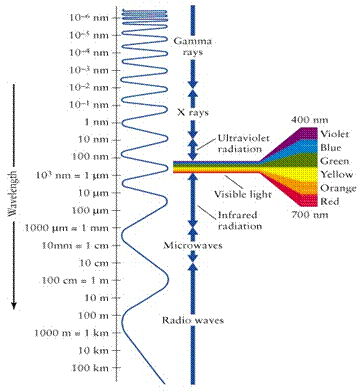Imagining light as a ray makes it easy to describe three well-known phenomena: reflection, refraction and scattering. Inreflection, a light ray strikes a smooth surface, such as amirror, and bounces off. A reflected ray always comes off the surface of a material at an angle equal to the angle at which the incoming ray hit the surface. In physics, this is called thelaw of reflection in which "the angle of incidence equals the angle of reflection."
Refraction is the bending of light as it encounters a medium different than the medium through which it has been traveling. This meeting place of two different media is called the interface between the media. All refraction of light (and reflection) occurs at the interface. This is the phenomenon that occurs when it looks like the straw in the glass in bending.
Of course, we live in an imperfect world and not all surfaces are smooth. When light strikes a rough surface, incoming light rays reflect at all sorts of angles because the surface is uneven. The surface of paper is a good example. The actual roughness of the paper becomes visible when viewed under a microscope. When light hits paper, the waves are reflected in all directions. This is what makes paper so incredibly useful -- you can read the words on a printed page regardless of the angle at which your eyes view the surface.
When light falls on an object, some is absorbed. The light that is not absorbed is reflected off the object's surface; this is the light we see. For an object to appear colored, it must absorb some part of the visible spectrum and reflect the rest. It was Isaac Newton who discovered that objects appear colored because of the character of the light they reflect.
To understand color, it is first necessary to be more specific about light. Light is usually defined as that portion of the electromagnetic spectrum visible to the average human eye. It is commonly called "visible light" and subdivided into seven major colors—red, orange, yellow, green, blue, indigo, and violet. Visible light lies on the electromagnetic spectrum in between infrared and ultraviolet light. This "visible light" corresponds to a wavelength range of 400 - 700 nanometers (nm) and covers a color range of violet through red. The human eye is not capable of "seeing" radiation with wavelengths outside the visible spectrum. Ultraviolet radiation has a shorter wavelength than the visible violet light; infrared radiation has a longer wavelength than visible red light. The white light is a mixture of the colors of the visible spectrum and conversely, black is a total absence of light.
Color can be defined both in objective terms, as the specific electromagnetic frequencies in the visible-light range, and in subjective terms, as something perceived and experienced by an individual. The objective components of color are: a source of radiant energy, like the sun or a light bulb; a medium through which that energy travels, such as air; and an object, such as an apple, that absorbs and reflects different portions of the light spectrum. The subjective components of color are: the apparatus that responds to the

reflected light (the cones and rods in the retina of the eye) and the brain that interprets the information received as color and generates sensations in response to that information. The optic nerve carries visual information from the cones and rods to the visual cortex of the brain, where the experience of color is made conscious and human emotions, associations, and memory are generated, a connection to the artistic response. The next section will deal more directly with the biology of visual processing.
When considering light and color together, it is important to discuss additive and subtractive mixing . This phenomena crosses the scientific and artistic fields in somewhat similar ways. Young students learn to identify primary colors in art class and experiment with mixing paints and creating new colors. Primary colors are defined as a set of three colors that, when mixed in various combinations, can produce every color in the spectrum. Scientists work with two sets of primary colors - red, green and blue when dealing with light (also known as additive primaries), and magenta cyan, and yellow when dealing with pigments (also known as subtractive primaries). Artists use only one set of primary colors - red, blue, and yellow. In all cases, all the possible colors of the visible spectrum can be obtained by mixing these primaries in different combinations and proportions.
When working with light, the scientist may use a process of combination called additive mixing, which can be demonstrated by projecting colored light in the three additive primaries onto a white screen. When green light is projected over red light on a white screen, the viewer will actually see yellow since the combination of red and green light is perceived as yellow. The combination of red and blue light is magenta, and the combination of green and blue light is cyan.